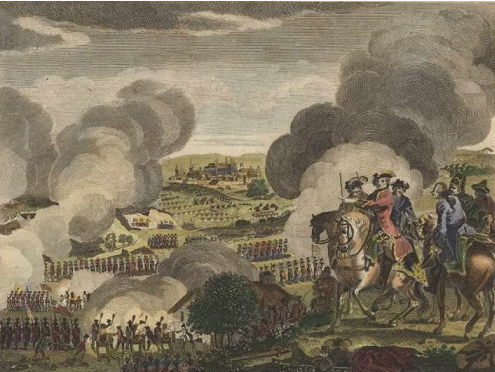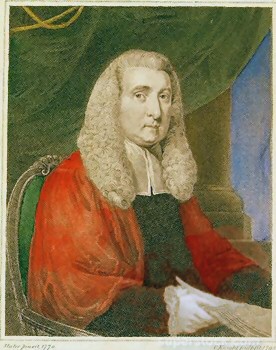|
Humphrey Sydenham (1694–1757)
Humphrey Sydenham (24 October 1694 – 12 August 1757), "The Learned", of Combe, Dulverton in Somerset, and of Nutcombe in Devon, was a Tory MP for Exeter, in Devon, between 1741 and 1754. Origins Humphrey Sydenham was the eldest son and heir of Humphrey Sydenham (1672–1710) of Combe, which family had long been seated at that place, by his first wife Eliza Peppin, daughter of George Peppin of Old Shute, Dulverton, which family after 1858 developed the Peppin Merino breed of sheep in Australia. Career He was a lawyer trained at the Inner Temple. Horace Walpole called him "a mad High Church zealot" though on another occasion he wrote that Sydenham was "an honest devout gentleman, who always talked out of the Common Prayer Book". He was temporarily ruined by the South Sea Bubble of 1720, in which he lost £20,000. St Barbe inheritance His financial situation was restored by a large inheritance from his great-great-uncle Sir John St Barbe, 1st Baronet (died 1723), MP, of Broadla ... [...More Info...] [...Related Items...] OR: [Wikipedia] [Google] [Baidu] |
Broadlands
Broadlands is an English country house, located in the civil parish of Romsey Extra, near the town of Romsey in the Test Valley district of Hampshire, England. The formal gardens and historic landscape of Broadlands are Grade II* listed on the Register of Historic Parks and Gardens. The house itself is Grade I listed. History The original manor and area known as Broadlands belonged to Romsey Abbey since before the Norman Conquest. In 1547, after the Dissolution of the Monasteries, Broadlands was sold to Sir Francis Fleming. His granddaughter married Edward St Barbe, and the manor remained the property of the St Barbe family for the next 117 years. Sir John St Barbe, 1st Baronet () made many improvements to the property but died without children, bequeathing his estate to his cousin Humphrey Sydenham of Combe, Dulverton. In the chancel of Ashington Church, Somerset, is a monument of grey and white marble, inscribed: Having been ruined by the 18th-century South Sea Bubble, ... [...More Info...] [...Related Items...] OR: [Wikipedia] [Google] [Baidu] |
British MPs 1741–1747
British may refer to: Peoples, culture, and language * British people, nationals or natives of the United Kingdom, British Overseas Territories, and Crown Dependencies. ** Britishness, the British identity and common culture * British English, the English language as spoken and written in the United Kingdom or, more broadly, throughout the British Isles * Celtic Britons, an ancient ethno-linguistic group * Brittonic languages, a branch of the Insular Celtic language family (formerly called British) ** Common Brittonic, an ancient language Other uses *'' Brit(ish)'', a 2018 memoir by Afua Hirsch *People or things associated with: ** Great Britain, an island ** United Kingdom, a sovereign state ** Kingdom of Great Britain (1707–1800) ** United Kingdom of Great Britain and Ireland (1801–1922) See also * Terminology of the British Isles * Alternative names for the British * English (other) * Britannic (other) * British Isles * Brit (other) * Br ... [...More Info...] [...Related Items...] OR: [Wikipedia] [Google] [Baidu] |
1757 Deaths
Events January–March * January 2 – Seven Years' War: The British Army, under the command of Robert Clive, captures Calcutta, India. * January 5 – Robert-François Damiens makes an unsuccessful assassination attempt on Louis XV of France, who is slightly wounded by the knife attack. On March 28 Damiens is publicly executed by burning and dismemberment, the last person in France to suffer this punishment. * January 12 – Koca Ragıp Pasha becomes the new Grand Vizier of the Ottoman Empire, and administers the office for seven years until his death in 1763. * February 1 – King Louis XV of France dismisses his two most influential advisers. His Secretary of State for War, the Comte d'Argenson and the Secretary of the Navy, Jean-Baptiste de Machault d'Arnouville, are both removed from office at the urging of the King's mistress, Madame de Pompadour. * February 2 – At Versailles in France, representatives of the Russian Empire ... [...More Info...] [...Related Items...] OR: [Wikipedia] [Google] [Baidu] |
1694 Births
Events January–March * January 16 – Francesco Morosini, the Doge of Venice since 1688, dies after ruling the Republic for more than five years and a few months after an unsuccessful attempt to capture the island of Negropont from the Ottoman Empire during the Morean War. * January 18 – Sir James Montgomery of Scotland, who had been arrested on January 11 for conspiracy to restore King James to the throne, escapes and flees to France. * January 21 (January 11 O.S.) – The Kiev Academy, now the national university of Ukraine, receives official recognition by Tsar Ivan V of Russia. * January 28 – '' Pirro e Demetrio'', an opera by Alessandro Scarlatti, is given its first performance, debuting at the Teatro San Bartolomeo in Naples. The opera is adapted in 1708 in London as Pyrrhus and Demetrius and becomes the second most popular opera in 18th century London. * January 29 – French missionary Jean-Baptiste Labat arrives in the "New World", landing at the C ... [...More Info...] [...Related Items...] OR: [Wikipedia] [Google] [Baidu] |
Inescutcheon
In heraldry, an escutcheon () is a shield that forms the main or focal element in an achievement of arms. The word can be used in two related senses. In the first sense, an escutcheon is the shield upon which a coat of arms is displayed. In the second sense, an escutcheon can itself be a charge within a coat of arms. Escutcheon shapes are derived from actual shields that were used by knights in combat, and thus are varied and developed by region and by era. Since shields have been regarded as military equipment appropriate for men only, British ladies customarily bear their arms upon a lozenge, or diamond-shape, while clergymen and ladies in continental Europe bear their arms upon a cartouche, or oval. Other shapes are also in use, such as the roundel commonly used for arms granted to Aboriginal Canadians by the Canadian Heraldic Authority, or the Nguni shield used in African heraldry (likewise, Christian organisations and Masonic bodies tend to use the same shape, also known ... [...More Info...] [...Related Items...] OR: [Wikipedia] [Google] [Baidu] |
Henry Temple, 1st Viscount Palmerston
Henry Temple, 1st Viscount Palmerston (c.1673 – 10 June 1757), of East Sheen, Surrey and Broadlands, Hampshire, was an Anglo- Irish landowner and Whig politician who sat in the British House of Commons from 1727 to 1747. Early life Temple was the eldest son of Sir John Temple, Speaker of the Irish House of Commons, and his wife Jane Yarner, daughter of Sir Abraham Yarner, muster-master general for Ireland. He was educated at Eton College from around 1689 to 1693 and was admitted at King's College, Cambridge in 1693. On 10 June 1703, he married Anne Houblon (1683 - 13 December 1735), the daughter of Abraham Houblon, a governor of the Bank of England. Political career In 1715, Temple acceded to a place as joint chief remembrancer of the court of Exchequer for Ireland, for which he was granted the reversion as a child in 1680. He was created Viscount Palmerston of Palmerston, County Dublin, and Baron Temple of Mount Temple on 12 March 1723. He helped Bishop Berkeley in h ... [...More Info...] [...Related Items...] OR: [Wikipedia] [Google] [Baidu] |
John Collinson (died 1793)
The Rev. John Collinson (19 July 1757 – 27 August 1793) was an English cleric, antiquarian and county historian. He is best known for his three-volume history of Somerset which he published at the age of 34, two years before his death, and which earned him the title of "the Somerset historian". Life Collinson was the son of the Rev. John Collinson of Bromham, Wiltshire, where he was born on 19 July 1757. He matriculated at Brasenose College, Oxford in 1775, but did not complete a degree course. He was ordained deacon in 1779 with the sponsorship of the Rev. Thomas Meyler (c.1718–1786), having made further studies at The Queen's College, Oxford. He was then curate to Meyler in 1780 at Marlborough. Collinson moved to Cirencester where in 1781 he married. In 1782 he was appointed vicar of Clanfield, Oxfordshire. At this period he published one book, and issued proposals for county histories, firstly of Wiltshire and then of Somerset. He associated with the antiquarians Jos ... [...More Info...] [...Related Items...] OR: [Wikipedia] [Google] [Baidu] |
Sir John St Barbe, 1st Baronet
Sir John St Barbe, 1st Baronet (c. 1655 – 7 September 1723), of Ashington, Somerset and Broadlands, Hampshire, was Member of Parliament for Ilchester in 1681. He was created a baronet on 30 December 1662 at the age of 7. Origins He was the second son of John St Barbe of Broadlands, MP for Hampshire in 1654 and a Parliamentarian in the Civil War, by his wife Grissell Pynsent, daughter of John Pynsent of Carleton-Curliew, Leicestershire and of Combe, Surrey, Prothonotary of Common Pleas. His ancestors had been seated at Ashington, near Ilchester, in Somerset, since the 14th century, and in the late 16th century inherited Broadlands in Hampshire by marriage to the heiress. Career In 1661 his elder brother died and John became heir to his father. In 1671 he matriculated at Magdalene College, Cambridge. In 1674 he entered the Inner Temple as a student of law. he was elected Member of Parliament for Ilchester in 1681 and served as Sheriff of Hampshire This is a list of H ... [...More Info...] [...Related Items...] OR: [Wikipedia] [Google] [Baidu] |
Combe, Dulverton
Combe is a historic estate in Somerset, England, situated between the town of Dulverton and the village of Brushford. Descent Taunton Priory Until the Dissolution of the Monasteries under King Henry VIII, the estate was one of the possessions of Taunton Priory, which also held the manor of Dulverton. Combe family In the medieval period the Combe estate was probably held by the Combe family, although in 1254 the lord of Dulverton, Richard de Turberville, held land there. Alfred of Combe, the Bailiff of Dulverton in 1225, may have come from the estate – doubt arises because Combe, meaning ''steep-sided valley'', is a common name in west Somerset.Combe Estate (.doc file) VCH Explore. Accessed 28 November 2016. In 1425 John Combe was a free tenant of Tau ... [...More Info...] [...Related Items...] OR: [Wikipedia] [Google] [Baidu] |
South Sea Company
The South Sea Company (officially The Governor and Company of the merchants of Great Britain, trading to the South Seas and other parts of America, and for the encouragement of the Fishery) was a British joint-stock company founded in January 1711, created as a public-private partnership to consolidate and reduce the cost of the national debt. To generate income, in 1713 the company was granted a monopoly (the Asiento de Negros) to supply African slaves to the islands in the "South Seas" and South America. When the company was created, Britain was involved in the War of the Spanish Succession and Spain and Portugal controlled most of South America. There was thus no realistic prospect that trade would take place, and as it turned out, the Company never realised any significant profit from its monopoly. However, Company stock rose greatly in value as it expanded its operations dealing in government debt, and peaked in 1720 before suddenly collapsing to little above its o ... [...More Info...] [...Related Items...] OR: [Wikipedia] [Google] [Baidu] |



